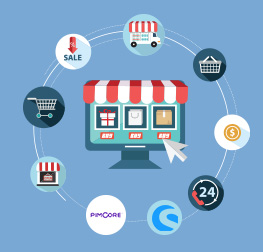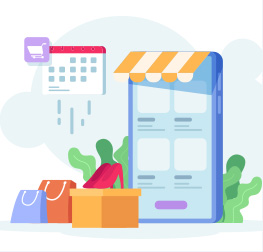Headless Commerce: All You Need To Know
When was the last time you wanted to leave behind and wait for one of your competitors to implement a new strategy so that you can follow them? I assume, never..!! No one wants to leave behind their competitor and be a copycat version of them.
Recent time pushes everyone to be three steps ahead of everything, and so is the need for Headless commerce. The wordless headless may sound scary at first, but it will make sure that you never get scared of any competition or any trending changes.
- What is Headless Commerce?
- Why Are People So Crazy Over Headless Commerce Right Now?
- How Headless Commerce Differs from Traditional Commerce
- How does headless commerce impact your customers?
- 5 Key Benefits of Headless Commerce
- Key Drawbacks Of Headless Commerce
- When Should an Ecommerce Retailer Go For Headless Commerce?
- Summarize
What is Headless Commerce?
Headless commerce is a process that gives you more flexibility, as it separates the front-end and back-end activities of your e-commerce. The separation of front-end activity and back-end activity allows each function to work independently and more precisely. Headless commerce gives retailers agility to customize the front end, the agility will give better tailoring to retailers, and they will be able to meet the needs of the customer.
Headless Commerce is a simpler concept; through which you can give your customers a better experience, and can meet up to their expectations in no time. Headless Commerce is another approach to give customers a better experience and customize customer journeys. Many Digital Commerce Platforms are available in the market that enables brands with highly advanced headless commerce abilities.
The API of Headless Commerce can deliver the right content to any screen or device, and then front-end developers can represent the right content to the customer in the form the customer wants.
Why Are People So Crazy Over Headless Commerce Right Now?
As stated earlier, Headless commerce brings agility and gives your business flexibility to cope up with trending changes and separate front-end activities with back-end activities; this makes Headless commerce one of its kind yet naturally fitting to all age business e-commerce. When something as headless commerce fits all business e-commerce; people are going crazy after this.
When retailers want to have access to content to deliver it to the right audience, Headless commerce pushes the content and architecture of headless commerce allows retailers to adapt to changes and make it available on a new platform.
The first motto of your business must be to earn as much profit as you can, and the second motto should be a happy customer. Meeting the customer’s needs is quite important when you want to sustain that customer. Customer convenience and comfort should be your top-most priority. Online customers want to have comfort which they do not get from traditional shopping.
The loyal customer’s expectations from retailers would keep on rising day by day; to meet up those expectations you need Headless commerce. To relieve the pressure of retailers to meet the needs of customers spontaneously, and to head start in fulfilling the needs of the customer you need headless commerce.
Thus, people are going crazy over headless commerce because it takes up the tension of retailers while allowing them to meet the needs of the customer. Headless commerce separates activity and API. Headless commerce pushes the right content to be delivered to the right audience at the right time.
How Headless Commerce Differs from Traditional Commerce
Three justifications prove that headless commerce is different from traditional commerce.
Traditional commerce vs. Headless commerce
1. Front-end Development
Front-end development in traditional commerce
There is no separation of front-end developers and back-end developers so that designs come with constraints. With constrained designs, you can only have access to those designs, which are compiled with back-end architecture.
Front-end development in headless commerce
In this, there is a clear separation of front-end and back-end activities and that separation allows you to have access to any design you want. The primary thing that you need to take care of is building the front end from scratch.
2. Customization
Customization in traditional commerce
Customization in traditional commerce is the pre-defined experience for customers and admin. There is a restriction of creating any new experience for your consumers.
Customization in headless commerce
In headless commerce, you can create your experience to satisfy your customers.
3. Flexibility
Flexibility in traditional commerce
In traditional commerce; the front-end and back-end are closely combined like a magnet. You are not allowed to pull them apart and hence making changes in either or both become difficult. Flexibility and adaptability are at their lowest in traditional commerce and that is one huge hindrance.
Flexibility in headless commerce
Due to its capability of working individually and efficiently, you can easily make changes in either or both of the front end and back end. There is a huge scope of adaptability due to individuality and hence there is a possibility of new applications and their usage.
How does headless commerce impact your customers?
Meeting customer expectations is a path to achieve your ultimate goal- Maximum profit. While your competitors might try hundreds of new things to sustain or attract the customer or apply different models; all you need to do is learn the impact of headless commerce and how it helps in meeting customer’s unique demands.
Instant changes and optimization
When new content is launched to the front end, traditional commerce takes longer than headless commerce to reflect the change. Headless commerce on the other hand takes updates in real-time and reflects them to customers instantly without any unwanted delay.
Rich Customer- Experience and User-Interface
You can implement experimental designs and be more creative with headless commerce. You can control elements that handle the user’s interface. You can publish creative content on your website real quick. Headless commerce also ensures that you have a seamless workflow in your work system.
The risk of missing important content from different devices and disappearing content from various devices is nearly minimal. Thus, the overall effect of headless commerce impacts customers and ensures that your customers’ needs are fulfilled.
5 Key Benefits of Headless Commerce
Headless commerce provides multiple benefits with some other e-commerce strategies.
1. Advanced technology for developing websites quickly
The front-end is decoupled from the back-end, so your brand can test other new technology. The front-end is the front face of your e-commerce that your customers see. Headless provides flexibility and lets you connect with CMS and other specially designed experience-led commerce.
The content is stored in the central platform of headless commerce and this content is available to deliver anywhere via API. The faster delivery of content brings you closer to delivering a better customer experience. You can interchange front-end and back-end without interrupting former with latter.
2. Agility for developers
Headless commerce gives you the adaptability of choosing a platform that works best for your eCommerce store. With front-end choice, you can also create a custom solution. Merchants can manage storefronts from the control panel.
Headless commerce does not intervene in the working pattern of developers. It lets them continue working on a certain technology or certain programs with language, which developers are comfortable with. So, your developers can work flawlessly and in a seamless work environment.
3. Time-to-market for international and Omni-channels
When advanced technology is present that can build a website real quick, when developers can create a program in their comfortable language with the support of headless commerce and when the individuality of the front-back end is there headless commerce gives you speed to market.
You can launch a new process in different geographical areas in real-time and you do not need to wait for launching new processes. Once the system is set up headless commerce takes care of the rest, so you can sit back and relax. Through headless commerce, you can have higher SEO internationally and overall data will stay connected.
4. Higher Conversion rates
As stated above, with headless commerce you are a step closer to a better customer experience. When you provide customers with what they ask for and when you fulfill their demands in real-time, you will have lower customer acquisition costs.
With a better customer experience and with the practice of delivering a better customer experience, you will have higher conversion rates with the help of headless commerce. Headless commerce is the best way to reduce acquisition costs and instead you can use that amount saved on some other important activities.
5. Complete Ownership
In headless commerce, the presence of individuality gives you complete control over site architecture and other things. Content management applications and content delivery applications are under great control.
Some e-commerce platforms prefer to have headless eCommerce because they have a front end, which is in complete control of the owner and they seek the same for the back-end. Headless commerce gives you complete control of the front-end and back-end system.
Key Drawbacks Of Headless Commerce
Every coin has two sides, likewise, headless commerce is also not a complete solution filled with a bag of advantages. It also has some limitations; below are the drawbacks of headless eCommerce that you should be aware of.
1. Headless commerce is accompanied by unwanted costs
One of the main drawbacks of headless commerce is that it does not come with a front end; developers need to create a frontend for the retailers. The creation of the front-end is not as simple as you may think it to be. Building the front-end requires a lot of time and money. For individual channels, costs even rise and these are unwanted costs, which you might want to avoid.
2. Implementation Time
Headless commerce takes time to implement. Front-end needs to be developed from scratch and rest building activities of headless commerce make it the system that requires time in implementation. It is convenient to find suppliers of headless commerce who take care of the implementation part.
3. Headless commerce can be complex at times
Retailers usually need to completely rely on front-end developers. Headless commerce gives flexibility and adaptability but that does not change the fact that headless commerce is a complex system. When changes need to be made in the system, the system becomes more complex.
However, while comparing the advantages of Headless commerce the drawback can be negligible. On knowing these many businesses are now switching to Headless commerce which is the latest trend in today’s market.
When Should an Ecommerce Retailer Go For Headless Commerce?
Now that you have measured the pros and cons of headless commerce, the next step is to know when to opt for headless commerce. It is not easy to know the need for headless commerce, so I have elaborated on important points that indicate the need for headless commerce.
1. Better Omni-channel Strategy
When you want a better Omni-channel strategy then headless commerce is the best option. When your brand utilizes more content or has the mindset of delivering a better customer experience, then headless commerce is the thing you want. AI capability of headless commerce can expand quickly and will give you a seamless workflow.
2. When you sell on multiple sites
When you sell on multiple sites, or when you have multiple websites for different countries then you need headless commerce. Headless commerce’s architecture will allow you to serve a different front-end system from one central back-end system. The central back-end system has all product content and product information live in it.
3. When you have a CMS setup
When you are already with the CMS setup and are just in need of commerce, then headless commerce is something you should consider. With setup CMS and headless commerce, you can decouple the front-end system and enjoy the perks of headless commerce.
4. When you want to merge content with commerce
Sometimes it does happen that you have an e-commerce website and content on two different websites. When you are tired of back and forth and want one system that takes care of content and commerce together, then you need headless commerce.
Summarize
Just like any other system, Headless commerce has advantages and disadvantages. You need to be smart and choose headless commerce because of the advantages it brings to your e-commerce business. For better customer experience and for the individuality of the front-end and back-end system you need headless commerce.
Headless commerce requires your developers to create websites and content from scratch for front-end systems, but headless commerce also gives your developers the flexibility to create content in their convenient language. Thus, you should overlook some minor drawbacks and should focus on the perks that Headless commerce brings.








Tags: